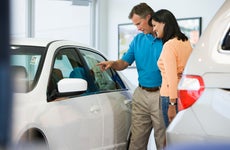Why do dealer car quotes vary among dealerships?

The Bankrate promise
At Bankrate we strive to help you make smarter financial decisions. While we adhere to strict , this post may contain references to products from our partners. Here's an explanation for .
Key takeaways
- Different dealerships have certain relationships with the manufacturer, and that can have a large impact on what they receive for manufacturer wholesale pricing after rebates and incentives.
- Other dealer situations like appraising trade-ins a certain way, different fees and certain locations can also impact car quotes.
- Dealerships often charge higher interest rates if you finance through them, so try to level the playing field by using an outside lender.
A car dealer quote for a new car depends on many factors beyond make and model. While every manufacturer sets a standard MSRP, it won’t be the final price you pay. The average new car costs around $49,000, according to Kelley Blue Book — but you may find the same car at higher or lower price points at different dealerships.
The dealership will rely on location, wholesale cost and other factors to pick a sticker price. It’s up to you to negotiate the cost to suit your budget.
Reasons car dealer quotes may differ
Car prices are extremely flexible. Dealerships know how much they need to charge to turn a profit — and may even pad your interest rate if you opt for dealership financing.
A car dealer quote relies on several factors, so even a common new car model will cost more at one dealership than another.
Manufacturer wholesale pricing isn’t set
Manufacturers sell their vehicles at different price points to dealerships. The invoice price — the amount the dealer pays — depends on the established relationship between the dealer and the manufacturer. While one dealership may receive a new car model at $40,000, another may receive it at $50,000. This is largely due to rebates and other incentives offered by the manufacturer.
This difference in wholesale value is passed on to the consumer. To improve profit margins, the dealership that bought the car at a higher price may charge you more even if the vehicles are the same. The MSRP, or manufacturer-suggested retail price, is not the maximum possible price. Dealership costs and other fees will be wrapped into the sticker price. For instance, market adjustment fees may also impact pricing.
Dealerships appraise trade-ins differently
If you plan on trading in your old car, know that dealerships have different standards and will present you with different offers for your trade-in. If you use your trade-in to offset your next vehicle’s price, the monthly payments won’t match up among dealerships.
You can make the most of your trade-in by shopping it around. You aren’t obligated to buy from a dealership that accepts your trade-in. Your best course of action will be to sell your current car at the best price and put the money toward your down payment.
If you trade in your old car and buy a new one from the same dealership, negotiate the two transactions separately. The sale price of your trade-in should not impact your next car’s purchase price.
Dealership fees vary widely
Dealerships charge fees for overhead, application processing and other parts of the car-buying process. Since these vary widely between dealerships and are worked into the overall cost of your vehicle, it may change the purchase price.
Most of these fees are negotiable — and there are even a few unnecessary dealer fees you should always try to avoid. Unnecessary added costs include:
- VIN etching.
- Gap insurance.
- Extended warranties.
These can all be bought individually from third parties. But some fees, like destination and documentation fees, are set by the state or your dealership. They must be paid and may not be flexible like other parts of the purchase price.
So even if you negotiate the price of the vehicle down and secure financing from outside the dealership, you may not get the best deal. This is why shopping around and getting quotes from multiple sellers is important. A lower price may be overshadowed by higher fees increasing the total cost.
Location matters
Dealerships may price the same vehicle differently because of location. Taxes — both local sales tax and other state taxes — will change the profit margin on a sale. And dealerships may charge a higher sticker price in high-income areas.
If you’re looking to avoid high taxes in your state by traveling, don’t bother. You will need to pay the tax rate of the state in which you register your vehicle. But it’s a different story if you find a great deal for a new car a few towns over. Travel could be worth it if you can save enough money to cover the time, gas and delivery expenses. You can also check the most affordable cities for buying used.
How outside financing can level the playing field
One of the biggest factors affecting your monthly payment is your interest rate. Dealerships work with lenders to offer financing, but to make a profit, they often upcharge interest. For instance, if you qualify for an APR of 10 percent, you may be quoted 12 percent by the dealership.
You can get around this by applying for financing with a bank, credit union or online lender. Since there’s no go-between, you’ll receive a more competitive interest rate. After getting preapproved with several outside lenders, you can see if the dealer will beat your best rate. Either way, you should be able to get the best rate for your financial situation with this tactic.
Getting outside financing can mean a lower monthly payment. You’ll also have more standing to negotiate the total vehicle cost with the dealership. If you only have $30,000 to spend, you can be firmer on the total purchase price, taxes and fees.
The bottom line
There are good reasons why the same car might cost you more at a different dealership. To get the best deal and lowest car dealer quote, research and walk in with financing. With the right negotiation, you could score a solid price. Consider taxes and fees when looking at your next ride’s overall cost.
Related Articles



